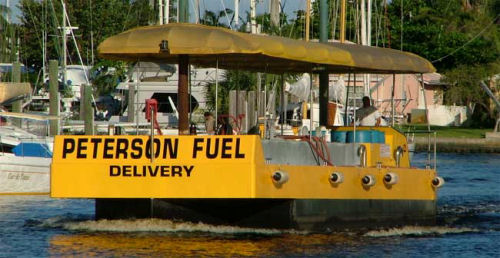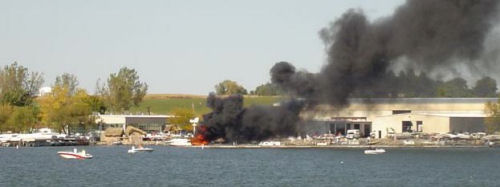How to Refuel Safely Every Time
Every year there are dozens of boat explosions after refueling. In fact, with a gasoline-powered boat, the moments just after refueling when the blowers are turned on and the engines are started is the precise time when explosions are most likely to occur. Fuel leaks can occur on any boat at any time in any number of places. While explosions after refueling typically happen on older boats, Murphy’s Law holds true for new boats as well.
 Don’t rely on the fueling station attendant to tell you how to refuel. You are responsible for safe refueling. |
During our 41 years chronicling recreational boating one thing that seems constant over the years is the recurrence of many boat explosions in the very same circumstances: Just after fueling and usually in older boats. Read the simple steps to fueling safety...
 |
Old Boats at Highest Risk
Because the boat explodes and sinks or is seriously damaged by fire, it is usually impossible for fire marshals to determine exactly what went wrong. Our theory as to why older boats explode occasionally after fueling is because wires leading to the blower or the ignition have become frayed over the years of bouncing and slamming around and when one or the other is turned on when there is a fuel leak – kaboom!
It may seem boy-scout to go through the procedures outlined below, but it is the best way to keep yourself and loved ones safe. It is also what virtually every veteran we know who operates a gasoline-powered boat does religiously. It only adds five minutes to your time at the fuel dock and if the skipper of the vessel is the one doing it while another member of the crew is settling-up the bill with the attendant, it may add no time at all.
How to Refuel Safely
1. Close all ports and hatches before refueling to keep fumes from the fill from entering the boat.
2. Ask occupants to stand on the dock before refueling.
3. After fueling is complete, open the engine hatch, stick your head down in the compartment and sniff for fumes. The human nose is the best fume detector.
4. Keep the hatch open and give the engine compartment time to dissipate any gas fumes which might be there.
5. Visually inspect for signs of fuel in the bilge, dripping from the fuel-fill pipe or at fuel line connections, of which there are usually a minimum of four.
6. When all looks and smells safe, turn on the engine blower and run it for 4 to 5 minutes, depending on guidance from your boat manual or the plate affixed next to the helm.
7. Start your engines. Then ask your passengers to board.
 |
Preventative Maintenance
Our advice is simply to get in the habit of following the above simple procedures until they become second nature. Your diligence will also rub off on those around you and teach them proper safety procedures as well.
Obviously, preventative maintenance is the best way to avoid boat fires and explosions. Periodic inspections of your fuel lines from the fill to the tank and from the tank to the engines is in order for all gasoline-powered boats. Likewise, electrical wires to the blower, engine and all other equipment should be inspected as far as possible for abrasion.
Please remember that a boat is not like a car. A boat’s innards get a lot more abuse from slamming and banging around than most automobiles. In fact, if people drove their cars the way they blast their boats through 2 and 3-foot waves – which at speed are like concrete – their automobiles would be rambling wrecks.